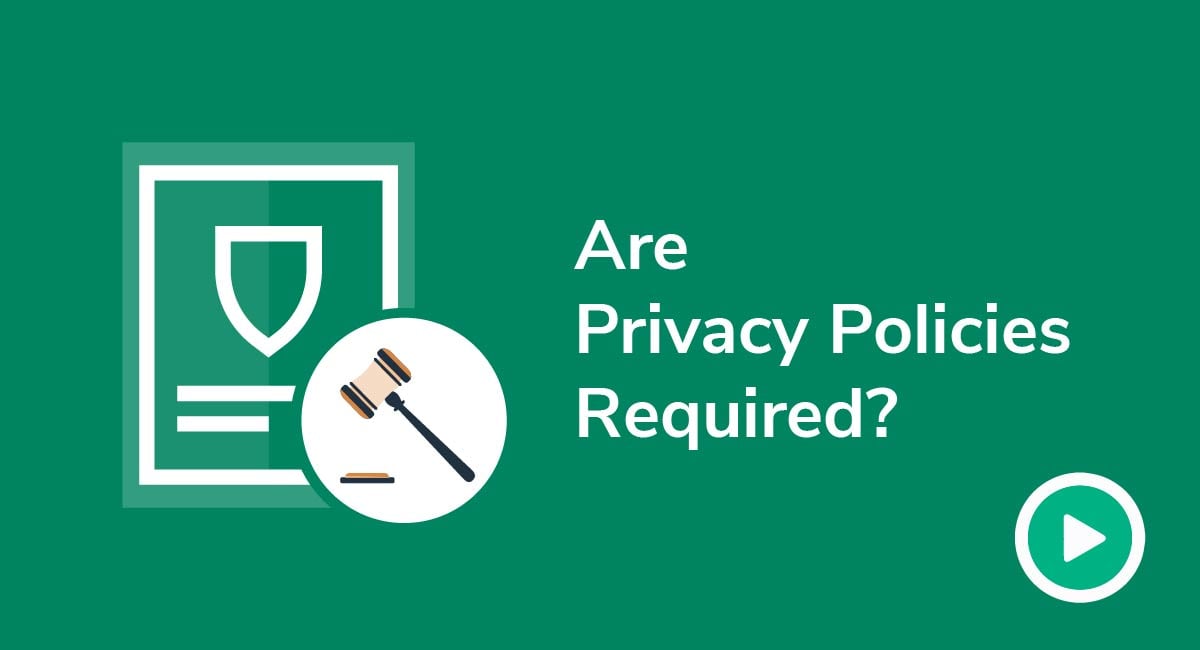Using All-Caps in Legal Agreements

Words, phrases, and entire sections of legal agreements are often capitalized to make them more conspicuous than the rest of the text around them. This tried-and-true practice has been around for ages and is still widely used today because it's a simple and effective way to make important content stand out.
In this article, we'll show you how to use all-caps to make your legal agreements rock-solid and reader friendly.
Get compliant today with PrivacyPolicies.com
Select one of our generators to create the required legal agreements for your business:
- Our Privacy Policy Generator can help you generate a customized Privacy Policy in around three minutes, for free.
- Our Terms & Conditions Generator can help you generate a customized Terms & Conditions agreement in around three minutes, for free.
- Our EULA Generator can create a customized End-User License Agreement for your mobile or desktop app.
- Our Cookies Policy Generator can create a customized Cookies Policy to help your compliance with ePrivacy Directive and GDPR.
- Our Disclaimer Generator can create a disclaimer or disclosure for your website.
- Our Return & Refund Policy Generator can help your ecommerce store by creating a returns or refunds policy.
Integrate a free Cookies Notice and Cookie Consent banner to comply with the EU ePrivacy Directive and the new GDPR law regarding cookies.
- 1. How Did All-Caps Gain in Popularity?
- 2. All-Caps, Conspicuous Text, and the UCC
- 3. How Do You Use All-Caps Effectively?
- 4. What are Some Examples of All-Caps in Online Legal Agreements?
- 4.1. All-Caps for General Emphasis
- 4.2. All-Caps in Warranty Disclaimers and Limitation of Liability Clauses
- 4.3. All-Caps in Privacy Policies
- 4.4. All-Caps in End User License Agreements (EULAs)
- 5. What are Some Alternatives to All-Caps?
- 6. Summary
How Did All-Caps Gain in Popularity?
Typesetting options were extremely limited before the digital age. Underlined letters often interfered with the text below them and made wordy documents even harder to read. In addition, all-caps were more convenient than using thicker, bolder letters when type was set manually.
As such, all-caps became the de facto method for making certain portions of legal agreements more conspicuous than others, because reader's attention is generally drawn to capitalized words and phrases. This is especially important because most readers do little more than skim even the most important documents, contracts, and legal agreements.
The use of bold, underlined, and italicized text did become more common with the advent of typewriters, computers, and word processors. However, old habits die hard, and it doesn't look like all-caps are going anywhere anytime soon.
All-Caps, Conspicuous Text, and the UCC
All-caps can make certain text, phrases, and clauses more conspicuous, but you're not required to use capital letters on any document or legal agreement.
Even so, all-caps became an effective tool for attorneys when the Uniform Commercial Code (UCC) was first published in 1952. The UCC was introduced to simplify and speed up commercial transactions between parties in different US states, territories, and the District of Columbia. It's been updated numerous times since then, but it's still in use today.
The UCC doesn't mandate the use of all-caps, but it defines conspicuous text as any text that a reasonable person "ought to have noticed."
For example, it states that all-caps can be used to make headings within a document or agreement more conspicuous, as long as the heading text is the same size or larger than the text in the clause itself.
All-caps is just one of many options for making some words and phrases more conspicuous than others. However, many attorneys and agreement writers use it more frequently than bold, underlined, and italicized text.
How Do You Use All-Caps Effectively?
There's no one right way to use all-caps effectively in a legal agreement. Some online legal agreements incorporate capitalized words and phrases sparingly, while others have entire sections that are written in all-caps.
The latter approach may satisfy the UCC's conspicuous text provision, but it also means that readers are confronted by a uniform wall of words in which nothing stands out from what's around it.
This is particularly true in large sections or clauses written entirely in all caps, especially when the text isn't broken up by subheadings, links, or bold, italic, or underlined text.
From the reader's perspective, using all capital letters is essentially the same as using no caps at all. But on the other hand, readers generally understand that anything presented in all caps is important and worth reading carefully.
What are Some Examples of All-Caps in Online Legal Agreements?
Much can be learned from looking at real-world examples that show how well-known companies use all-caps to make certain portions of their legal agreements more conspicuous than others. Here's how some of them do this.
All-Caps for General Emphasis
All caps are often used for general emphasis at the beginning of legal agreements like Terms and Conditions (also called Terms of Use or Terms of Service).
This makes sense, because it's wise to let visitors know that they should read the document in its entirety, and that they shouldn't proceed to the website or purchase a product or service if they don't understand or agree to the terms contained therein.
In the following example, Dana uses all-caps in the introductory paragraph of its Terms of Use:

Here, Dana lets visitors know that they should read the terms carefully and that they shouldn't continue using the site if they don't accept and agree to them.
In the following example also from Dana, the company uses all-caps in a portion of the clause that addresses third-party links:

This text presented in all-caps lets readers know that:
- Dana has no control over third party sites
- The company disclaims all liability
- Users who follow links do so at their own risk
Dana uses all-caps sparingly in most of the document, but a number of sections are presented in all caps.
All-Caps in Warranty Disclaimers and Limitation of Liability Clauses
These days, businesses face more risk and liability than ever before. To protect themselves, savvy developers and business owners generally include limitation of liability clauses and warranty disclaimers in their online legal agreements.
Without them, they may be on the hook for damages if their system crashes, if the user's data is stolen by hackers, or if anything else happens outside the owner's control.
In many cases, warranty disclaimers and limitation of liability clauses are written entirely in all-caps. By presenting text in all-caps, it's more likely that visitors will take the time to read and understand it before moving on.
When visitors have the information they need, they'll be able to decide whether they want to continue or move on to greener pastures elsewhere.
Here's an example of the first paragraph of the Disclaimer clause in Dana's Terms of Use, which is written entirely in all-caps:
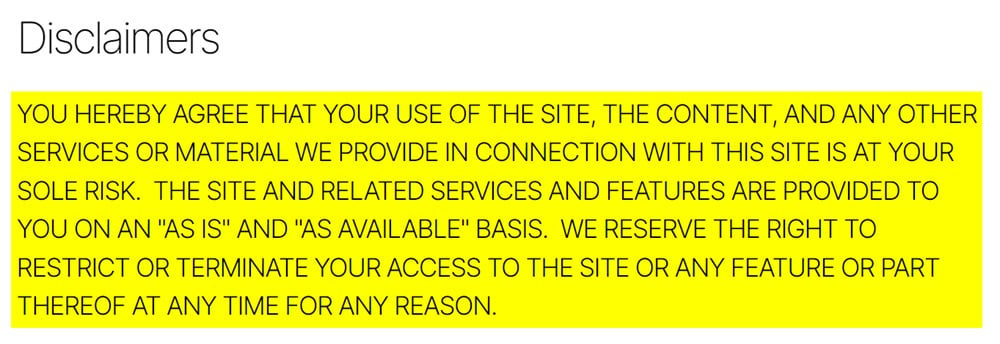
It's worth noting that the second paragraph is also presented entirely in all-caps.
In this example, Kroger uses all-caps in the limitation of liability clause found in its Terms and Conditions agreement:
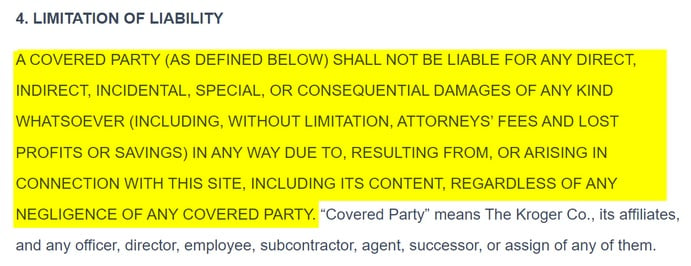
All-Caps in Privacy Policies
Because no two Privacy Policies are exactly alike, all-caps are sometimes used to highlight the most important terms, phrases, and sections.
However, one major difference between Privacy Policies and most other online legal agreements is that you're legally required to have a Privacy Policy.
As a business or website owner, you need to make sure your Privacy Policy doesn't leave anything to chance, especially if you collect, store, analyze and share user's personal information.
In addition, using all-caps in your Privacy Policy is a great way to highlight sections that pertain to privacy laws and regulations.
Privacy Policies are among the most important of all online agreements, but even so, many don't contain any sections presented in all-caps. You may choose to use all-caps to make some portions of your Privacy Policy more conspicuous than others, but you're not required to.
Dana's Privacy Notice has no words, phrases or sections that are presented in all-caps.
But in the following example, Airsoft United uses all-caps in its Privacy Policy headings to help make sections stand out:
![]()
This makes the questions more conspicuous and allows readers to scroll through the document and find the topics that relate to them quickly.
All-Caps in End User License Agreements (EULAs)
As with other legal agreements, all-caps are sometimes used in EULAs to make some sections more conspicuous than others. It's common for the introduction of an EULA to be presented in all-caps because this immediately alerts visitors that it's important enough to warrant a thorough read.
In the introduction to its End User Agreement, Spotify uses all-caps to let readers know about its mandatory arbitration policy:

The following example shows how Apple uses all-caps liberally in the Limitation of Liability section of its Licensed Application End User License Agreement:
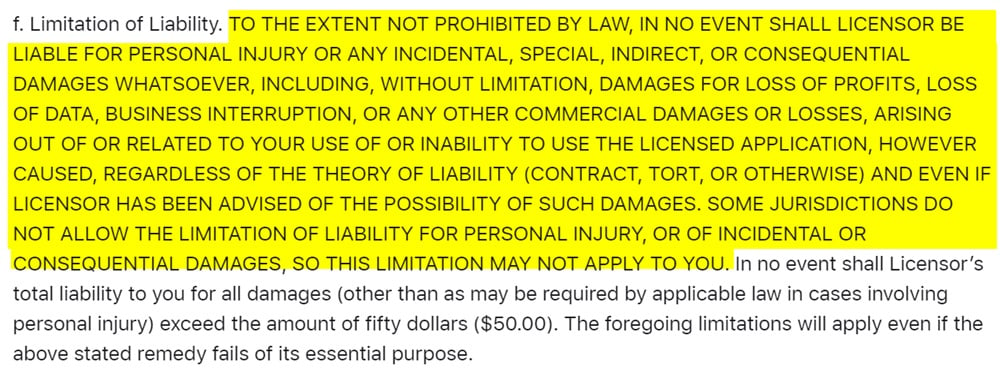
What are Some Alternatives to All-Caps?
Bold, italics and underlined text are commonly used as well, as are other methods like colored text and placing important sentences or paragraphs inside boxes with highlighted or colored backgrounds.
These latter methods are gaining ground because most agreements are read online instead of being printed.
It's also worth noting that multiple methods can be used in conjunction with one another. If you go this route, just make sure that your legal agreements are too busy, distracting, and difficult to read.
In this example, Delta uses bold text in the beginning of its Privacy Policy to let readers know that the company reserves the right to modify the document at any time without notice:
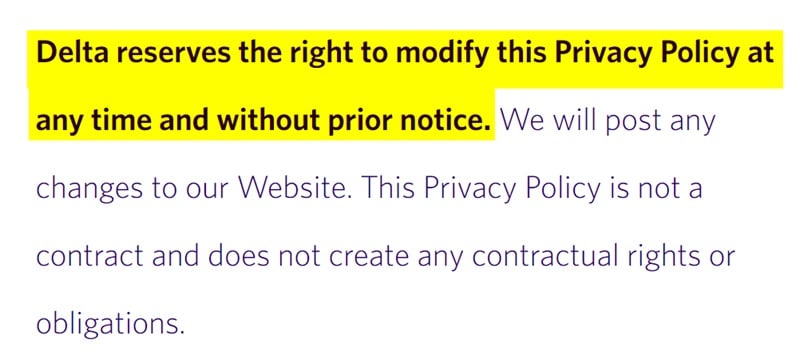
In the following example, Dutch Bros Coffee combines all-caps and bold text to highlight headings in its Terms of Service agreement:

Summary
All-caps have traditionally been used to make some text in legal agreements more conspicuous. That said, you're not required to use all caps in any legal agreement even if you want to highlight words, phrases or entire clauses.
If you do want to make some content more conspicuous than what's around it, you can use all-caps, italics, and colored or underlined text as well.
The goal is to make your legal agreement easy to read, with the most important text standing out as much as possible.


